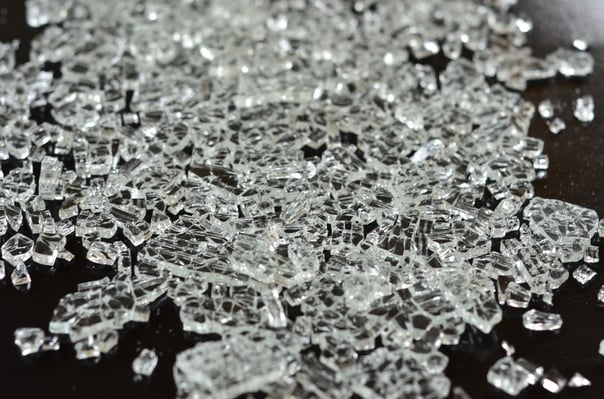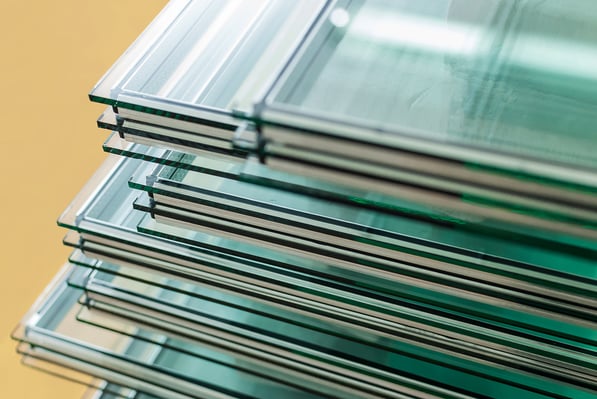What is Tempered Glass and Where is it Used?

What is Tempered Glass?
Tempered glass is a type of glass that is processed with thermal or chemical treatments, which increase its strength. The process of tempering leaves the outer surface of the glass in a state of compression and the interior in a state of tension. Due to these mechanical stresses, the tempered glass breaks into granular pieces instead of shards with sharp edges, reducing the chance of injury. Tempered glass is also known as toughened glass or safety glass.
Due to its safety and strength, tempered glass is used in many industries and applications, including construction projects. Some uses for tempered glass include vehicle windows, shower doors, refrigerator trays, architectural components, cell phone screens, and cookware.
Make sure your building uses the safest materials.
Tempered Glass Properties
Tempered glass is both physically and thermally stronger than conventional glass. As previously mentioned, tempered glass is treated to create exterior and interior stress in the material. The compressive surface stress of tempered glass is balanced by the tensile stress in the body.
For glass to be classified as tempered, its surface must have a minimum compressive stress of 69 megapascals (10,000 psi). Then, for a tempered glass to be considered safety glass, its surface compressive stress must exceed 100 megapascals (15,000 psi). If tempered glass breaks, the increased surface stress will result in small circular pieces instead of sharp shards. This property makes tempered glass suitable for high-pressure and explosion-proof applications.

Tempered glass gets its strength from the compressive stress on its surface. On the other hand, annealed glass has almost no internal stress, making it very fragile - it forms microscopic surface cracks that break under tension. Tempered glass does not have these surface cracks, and this prevents propagation or expansion when breaking.
Advantages and Disadvantages of Tempered Glass
Advantages of Tempered Glass:
- High Strength – It is 4-5 times stronger than regular glass, making it more durable.
- Safety – When broken, it shatters into small, blunt pieces, reducing injury risks.
- Heat Resistance – It can withstand high temperatures and thermal shocks.
- Scratch Resistant – More resistant to scratches compared to regular glass.
- Impact Resistance – Can handle moderate impacts without breaking easily.
- Versatility – Used in various applications like windows, mobile screens, and car windshields.
- Better Aesthetics – Provides a smooth, polished, and modern look.
Disadvantages of Tempered Glass:
- Cannot Be Cut or drilled – Once tempered, it cannot be modified without breaking.
- Expensive – Costs more than standard glass due to the tempering process.
- Spontaneous Breakage – Rarely, due to internal impurities like nickel sulfide, it may shatter unexpectedly.
- Less Flexibility – Not suitable for applications requiring bending or shaping.
- Not Shatterproof – While safer than normal glass, it still breaks under extreme pressure.
- Weaker Edges – The edges are more vulnerable to damage and can cause complete breakage if hit hard.
Applications of Tempered Glass
Tempered glass is used in applications that require thermal resistance, strength, and safety. Passenger vehicles are a great example of the three conditions:
- Since they are often parked outdoors, vehicles are subject to constant heating and cooling (thermal resistance).
- Vehicles must also resist small impacts from road debris (strength).
- Sharp shards of glass represent an additional hazard if an accident occurs, and tempered glass does not break into shards (safety).
The properties of tempered glass make it suitable for construction projects and many industrial applications.
Commercial Buildings:
Tempered glass has many applications in the construction industry, which include commercial building envelopes and facades. Tempered glass can also be used in unframed assemblies such as frameless glass doors. Tempered glass is suitable for structurally loaded applications in general and any application where glass can be a hazard in the event of human impact:
- Partitions for homes, offices, hotels, and other commercial buildings.
- Doors and windows
- Decorative panels in interior design
Building codes demand the use of tempered or laminated glass in several cases. These include skylights, doorways, stairways, elevators, and fire department access panels. Consider that specific requirements change depending on local codes.

Residential Construction:
Tempered glass is also used in homes. For example, some types of furniture and household appliances have tempered glass parts:
- Glass tabletops
- Frameless shower doors
- Glass shelves
- Cabinets
- Glass near fireplaces
Foodservice Applications:
Tempered glass products can be found in restaurants, hotels, bars, and other food service applications. They increase safety standards in these applications by reducing the chance of glass-related accidents. Some types of tempered glass are designed for cooking and baking, which means they can be used safely in ovens and other cooking devices.
According to research, Saint-Gobain, AGC Inc., Viracon, Guardian Industries, and PPG Industries are the top 5 prominent tempered glass manufacturers in the USA.
Tempered Glass VS Film
| Factors | Tempered Glass | Window Film |
|---|---|---|
| Strength & Durability | 4-5 times stronger than regular glass, resists impact, heat, and scratches. | Offers some impact resistance but primarily prevents shattering. |
| Safety | Breaks into small, blunt pieces, reducing injury risk. | Holds shattered glass in place, preventing shards from spreading. |
| Heat & UV Protection | It can withstand high temperatures but does not block UV rays. | Blocks UV rays, reduces heat, and helps in energy savings. |
| Flexibility & Customization | It cannot be cut or modified after manufacturing. | Can be applied on existing glass and replaced easily. |
| Cost | More expensive due to the tempering process. | More cost-effective and affordable. |
| Installation | Requires complete glass replacement if broken. | Can be applied to existing glass without replacement. |
| Privacy & Aesthetics | Clear, transparent, and gives a premium look. | Can be tinted, frosted, or decorated for privacy and style. |
| Security | Stronger than regular glass but still breakable. | Prevents glass from breaking easily, enhancing security. |
| Best For | Suitable for car windshields, doors, and areas needing durability. | Ideal for home/office windows, UV protection, and privacy. |
NY Engineers specializes in integrating tempered glass into various projects, ensuring both safety and aesthetic appeal. Their expertise encompasses selecting appropriate glass types, adhering to safety standards, and customizing designs to meet specific client needs. By collaborating with NY Engineers, clients can achieve durable and visually appealing solutions for their construction and design projects. Contact us via email (info@ny-engineers.com) or phone ((786) 788-0295), and make sure your building systems meet codes.
FAQs
Tempered glass is used for safety and durability in applications like windows, doors, shower enclosures, car windows, and smartphone screens. It is stronger than regular glass and shatters into small, less harmful pieces when broken.
Tempered glass is up to five times stronger than regular glass and is heat-treated for durability. It shatters into small, blunt pieces for safety and is resistant to heat, impact, and scratches. Once tempered, it cannot be cut or reshaped.
Tempered glass cannot be traditionally recycled because it shatters into small pieces and has a different melting point than regular glass. However, it can be repurposed for construction materials, countertops, or landscaping.
Tempered glass is highly durable, heat-resistant, and shatters into small, safe pieces, reducing injury risk. It is used in safety applications like car windows, doors, and screens, offering strength and reliability.

Keith Fink
Keith is the Franchise Brand Manager at NY Engineers, Keith is all things related to our project portfolio, brands and all things you need to know before we start your project.
Related Posts
Join 15,000+ Fellow Architects and Contractors
Get expert engineering tips straight to your inbox. Subscribe to the NY Engineers Blog below.
